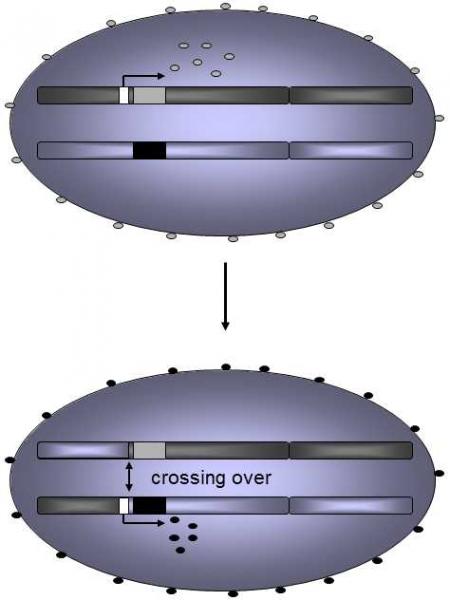XII.6.1.2.1 The absence of the Weismann barrier and the feasibility of intra-individual selection in plants subject them to a certain type of Lamarckian microevolution
The absence of the Weismann barrier in plants and thus the possibility of intra-individual selection of cell lines secondarily facilitate a certain type of Lamarckian microevolution, specifically for effective and simultaneously hereditary adaptation of the individual to the local conditions of the habitat.Simultaneously, this ability can be extremely important for immobile plants that cannot move from an unsuitable habitat to a more suitable habitat, as can animals.The experience of plant breeders and physiologists shows that the body of a plant is frequently a genetic mosaic and that the individual cells from which its tissues and organs are formed differ in their genetic information.For example, it is known that at least 5000 of all 8800 plant varieties grown in Europe in 1899 were originally obtained as somatic mutants (Whitham & Slobodchikoff 1981).Simultaneously, the genetic diversity of plant cells is partly derived from classical mutations, partly from various types of directed mutations, frequently connected with transposon activity, and a substantial part apparently arises as a consequence of mitotic recombination.In mitotic recombination, DNA sections on pairs of homologous chromosomes, in two chromosome sets that the organism has available, change places.Thus, cells with new genotypes are not actually formed, but only with new pairs of recombined haplotypes.Nonetheless, these cells can differ in their biological properties.This difference is caused by the “position effect” (Goldschmidt 1946)(Fig. XII.5).As gene expression is generally controlled by regulation elements occurring in the DNA in the vicinity of the actual gene, it can readily occur that an allele that was highly expressed on the original chromosome ceases to be expressed following transfer to the homologous chromosome and rather the second allele begins to be expressed.

Fig. XII.5 Position effect. The phenotype of the cell can also change as a consequence of recombination between two homologous chromosomes of a single cell, i.e. as a consequence of somatic recombination. If recombination occurs in the region between a gene and the regulation element controlling its expression, recombination can lead to turning off of synthesis of the protein encoded by one allele and turning on of synthesis of the protein encoded by the other allele. The genotype of the cell is not changed by somatic recombination, but the position effect can change its phenotype.
As soon as the individual cells in the plant differ genetically and in phenotype, natural selection can occur amongst them.Cells whose phenotype corresponds better to the local conditions of the habitat of the particular plant multiply and grow faster so that, finally, their progeny or their genealogical relatives and thus also genetically (or epigenetically) similar cells in the tissues of totipotent meristems predominate and lead to the formation of the generative organs of the particular individual (Pineda-Krch & Lehtila 2002)(see Fig. III.11).Similar intra-individual selection can, of course, occur even more readily at the level of the individual plant organs, e.g. branches.Thus, more effective adaptation to external conditions can occur in plants in this way and the individual adaptations can be transferred to the next generation both vegetatively and by sex cells .
The Sir Sebright effect can also apply at the individual level to organisms without a Weismann barrier.Lysenkoists described experiments in which two plants cultivated by cloning from a single rhizome were crossed together.They stated that the progeny obtained are more viable when the two plants were grown under different conditions, e.g. one in dry and one in damp soil, than if they are grown under the same conditions (Turbin 1952, p. 138).It is quite possible that the Lysenkoists thought up this result, similar to a great many others.However, it is also possible that the Sir Sebright effect was manifested in their experiments, i.e. that intra-organism cell-line selection selected genetically different cell lines of the parent plants under different conditions and that genetically different germinal cells gradually formed from them.The combination of genetically different germinal cells subsequently led to the formation of more viable progeny than would have been formed by combination of genetically more similar germinal cells derived from plant clones kept under the same conditions.In addition to classical somatic mutations, the source of variability for intra-organism selection could, of course, also have been epigenetic changes (see II.8).s
